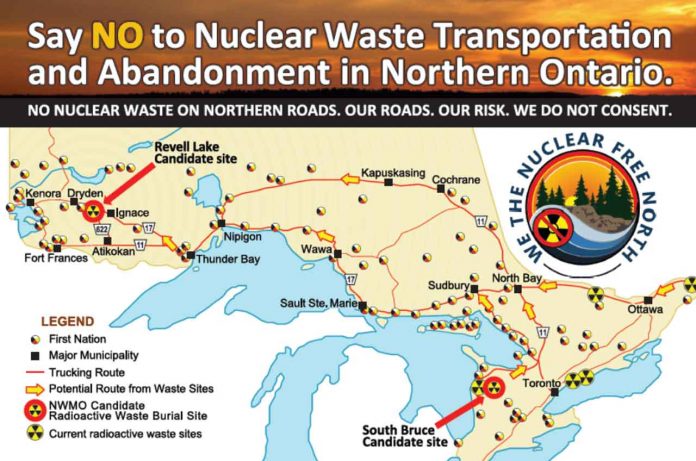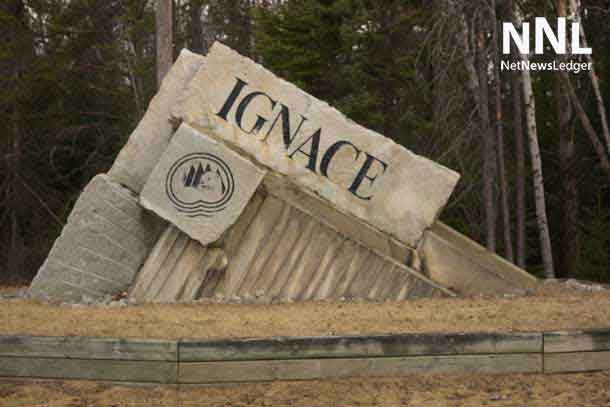Plans by the Nuclear Waste Management Organization (NWMO) to truck nuclear waste across Northern Ontario are outlined in postcards from We the Nuclear Free North that are landing in the mailboxes of residents from Wabigoon to Temagami this week.
The postcards alert residents to the potential routes and the hazards of transporting an estimated 100,000 tonnes of highly radioactive nuclear waste using highways that would traverse Northern Ontario for a period of 45 years or more.
The plan for transport and burial is being promoted by the NWMO, a consortium of the companies that operate nuclear power reactors in Canada. One of two potential sites is between Ignace and Dryden, in the heart of Treaty 3 territory, where the industry proposes to bury the radioactive wastes in a series of chambers to be constructed approximately 500 metres below the surface. The plan and design of the surface and sub-surface facilities and the transportation containers are all still under development, but the NWMO has said it intends to choose the site in 2023.
The NWMO has studied several potential locations over the last decade, but in 2021 announced that it was shortlisting to just two potential sites, one in Teeswater within the municipality of South Bruce in Southwestern Ontario, and the other in an area between Ignace and Dryden in Northwestern Ontario.
The NWMO asserts that it will only proceed with an ‘informed and willing host” but in the case of the candidate site in Northwestern Ontario, the NWMO identifies the Township of Ignace as the “host” community, despite the potential site being more than 40 kilometres outside the Ignace municipal boundaries.
“Not only is Ignace a long way away from the site – there are several small communities that are much closer – but Ignace’s council has decided that the Council itself will make the decision on whether to proceed, on whether Ignace is ‘willing’. There will not be a vote or plebiscite, even for residents of Ignace,” explained Wendy O’Connor, a volunteer with We the Nuclear Free North.
“This is not an issue for one community and certainly not for one corporation – it is an issue for the entire region, including those downstream and those along the transportation route”, commented Dodie LeGassick, a spokesperson for Environment North.
“We’re very concerned about the exposure of residents along the transportation route, particularly if there was an accident. Ignace should not get to decide whether 22,000 trucks hauling radioactive waste are driven through Nipigon, and through Shuniah Township (just east of Thunder Bay), and all of the many other communities along the route. It is thousands of kilometres from the reactor sites to the DGR candidate site between Ignace and Dryden, and the residents and communities along the way will bear the transportation risks.”
Brennain Lloyd, with the Northeastern Ontario-based coalition Northwatch, points out that the NWMO’s plans are still in the “concept” stage, with three different transportation containers included in the plan, none of which have been subject to actual testing and one still in the concept stage.
“The NWMO and the Canadian Nuclear Safety Commission like to describe the different tests and standards that transportation containers are subject to, but they gloss over that these particular containers have not been subjected to full-scale actual real-world testing. We have asked for the documentation to support their generalized claims, and the CNSC replied that it would take eight months to find the reports. We’re still waiting.”
We the Nuclear Free North will be hosting a webinar on transportation risks on Tuesday, June 7th at 7 pm Eastern.
The Revell Lake area is being studied as the potential site for a deep geological repository for all of Canada’s high-level nuclear waste, which is the irradiated fuel waste from reactors in Ontario, Quebec and New Brunswick. The irradiated fuel waste is one million times more radioactive than the original uranium used as fuel, and some of the hundreds of different radioactive isotopes contained in the fuel will remain radioactive for millions of years. Even a low level of exposure to radioactive materials can be harmful to human health.
The group points out on their website (WeTheNuclearFreeNorth.ca) that there is no other operating deep geological repository for high-level nuclear waste anywhere in the world. The web site provides information about technical and scientific uncertainties surrounding the controversial concept, including transportation risks related to low levels of gamma radiation that the transport containers will emit, and the risks of transportation accidents.







